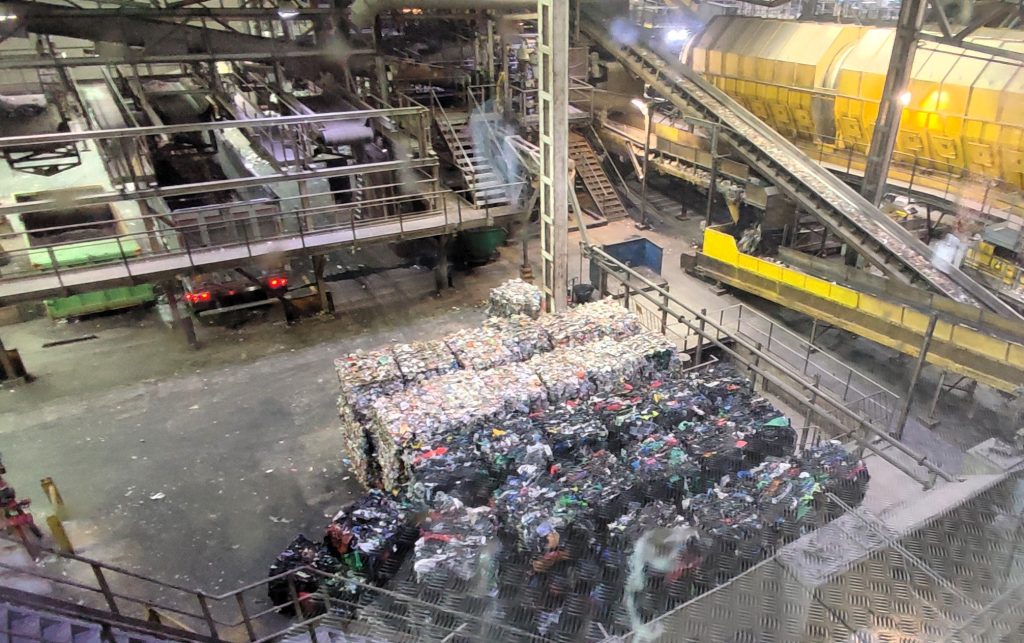Area Metropolitana de Barcelona places great emphasis on the responsible use of resources. We visited two extremely important objectives for what it means to recycle and reuse resources: the water treatment plant EDAR del Prat de Llobregat and Ecopark 3 Sant Adrià de Besòs. 420 million liters of domestic water or used in industrial processes are treated and reused every day. The waste is sorted to recover as much raw material as possible and what cannot be recycled is transformed into electricity.
EDAR del Prat de Llobregat
The El Prat de Llobregat water treatment plant is one of the most modern and among the largest in Europe. 420 million liters of water are treated daily, the equivalent used by two million citizens and related businesses. The station has been operating since 2002 and covers 36 hectares, with the possibility of expansion if such a project is needed in the future.
Homes, offices, shops, schools and any other places that do not have special pollution conditions send water to the station, together with that used in industrial processes but which is pre-treated to extract pollutants.

With the help of filters, small waste is sorted differently than large waste. Residual garbage goes to the landfill. Through anaerobic digestion, biogas is produced which covers 40% of the energy needs of the treatment plant. Between 13 and 15 tons of waste are used for biogas every month. In addition, the waste material can be used as construction material for road repair.
The station is located in the Llobregat River Delta and treats the water of the Baix Llobregat sanitation system. The area has a significant industrial footprint and purifies 36% of the total water in the Barcelona Metropolitan Area.
What is special about this station is that the reclaimed water increases the region’s water resources by 50 million liters annually. Purified water is cleaned so that it can be reused in activities such as irrigation and street cleaning, maintaining the flow of the Llobregat River and industrial uses.
Ecopark 3 Sant Adrià de Besòs

The next place we visited was Ecopark 3, a station dedicated to the treatment of municipal waste. There are three scenarios for the waste entering the sorting line: raw material recycling, use of residues in public paving or repair works, or incineration for energy production.
From the area where the waste is stored, it goes up a belt that selects it into recyclable materials and organizes it with the help of two other semi-automatic control and monitoring lines. The entire process is carefully monitored by an employee in the control room. The ensemble consists of the primary sorting equipment, rotary sieves, ballistic separators, magnetic separators, film separators, secondary sorting cabins, automatic classifiers and inductive separators. What cannot be recycled goes on a separate underground lane to the incinerator.

The organic matter obtained after the selection process is subjected to pretreatment. The resulting slurry is passed through a sand trap and hydrocyclones to extract any unsuitable material it still contains, both heavy and floating. Afterwards, it is introduced into two digesters where the organic matter fermentation reactions take place. Following this process, a gas rich in methane and a residue of digested material is obtained.
The produced biogas accumulates in the upper part of the digesters from where it is extracted. One part is compressed and reintroduced into the tank in such a way as to guarantee a constant agitation and to avoid precipitation of materials in the tank. Three engines produce 22 GWh/year, of which approximately half is used for self-consumption and the other half is exported to the electricity grid.
The energy produced by thermal combustion is sold in the network because the stations have ensured their autonomy through the amount already produced. 100 people work in three shifts at the Ecopark we visited. 360,000 tons are incinerated annually, that is 1000 tons per day. It is estimated that between 30% and 40% of the raw material is recovered. 2.8 million m3 of biogas, 5,200 MWh, 10,000 tons of residue for repairs and 19,000 tons of raw material are recovered annually.
The challenge for effective waste management is to collect it separately so that so much raw material that can be reused is not wasted. In the future, it is predicted that these containers where citizens throw their waste will be closed and there will be a payment system for how much garbage each household produces. If it is counted with the help of sensors that the waste is mixed, the person who threw it away will pay more. Arrive at Ecopark, each waste line will have a separate lane according to the raw material that can be recovered.
These two best practice models are the key to how cities can reach a circular economy based on the responsible use of resources. It’s inspiring to see how trash is used effectively and not just stored in certain areas as we’ve seen happen in other cities. The fact that even the way water is used has been thought about circularity instead of continuous consumption demonstrates how AMB looks to the future, understands the challenges of climate change and generates solutions for sustainable communities.
This article is part of the EU Commission project Functional Areas in the EU







